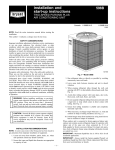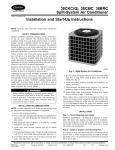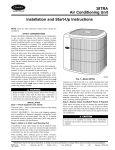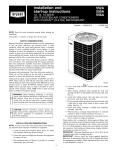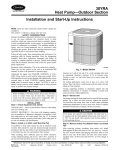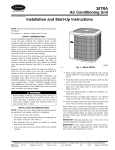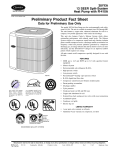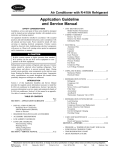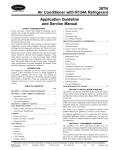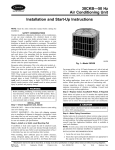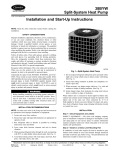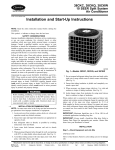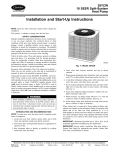Download Carrier 38QH Air Conditioner User Manual
Transcript
38TXA 13.0 SEER Air Conditioner With R-410A Installation and Start-Up Instructions NOTE: Read the entire instruction manual before starting the installation. SAFETY CONSIDERATIONS Improper installation, adjustment, alteration, service, maintenance, or use can cause explosion, fire, electrical shock, or other conditions which may cause personal injury or property damage. Consult a qualified installer, service agency, or your distributor or branch for information or assistance. The qualified installer or agency must use factory-authorized kits or accessories when modifying this product. Refer to the individual instructions packaged with the kits or accessories when installing. Follow all safety codes. Wear safety glasses and work gloves. Use quenching cloth for brazing operations. Have fire extinguisher available. Read these instructions thoroughly and follow all warnings or cautions attached to the unit. Consult local building codes and the National Electrical Code (NEC) for special installation requirements. Recognize safety information. This is the safety-alert symbol . When you see this symbol on the unit or in instructions and manuals, be alert to the potential for personal injury. Understand the signal word DANGER, WARNING, or CAUTION. These words are used with the safety-alert symbol. DANGER identifies the most serious hazards which will result in severe personal injury or death. WARNING signifies hazards which could result in personal injury or death. CAUTION is used to identify unsafe practices which would result in minor personal injury or product and property damage. R-410A systems operate at higher pressures than standard R-22 systems. Do not use R-22 service equipment or components on R-410A equipment. Before installing or servicing system, always turn off main power to system. There may be more than 1 disconnect switch. Turn off accessory heater power if applicable. Electrical shock can cause personal injury or death. INSTALLATION A92446 Fig. 1—38TXA INSPECT EQUIPMENT — File claim with shipping company prior to installation if shipment is damaged or incomplete. Locate unit rating plate on unit corner panel. (See Fig. 4.) It contains information needed to properly install unit. Check rating plate to be sure unit matches job specifications. Step 2—Install on a Solid, Level Mounting Pad If conditions or local codes require unit be attached to pad, tiedown bolts should be used and fastened through knockouts provided in unit base pan. Refer to unit mounting pattern in Fig. 4. to determine base pan size and knockout hole location. When installing, allow sufficient space for airflow, wiring, refrigerant piping, and service. Allow 30-in. clearance to service end of unit and 48 in. above unit. For proper airflow, a 6-in. clearance on 1 side of unit and 12 in. on all remaining sides must be maintained. Maintain a distance of 24 in. between air conditioners. Position so snow, ice, and water from roof or eaves cannot fall directly on unit. Specifications for this unit in residential new construction market require outdoor unit, indoor unit, refrigerant tubing sets, metering device, and filter drier listed in presale literature. There can be no deviation. Consult Application Guideline and Service Manual to obtain required unit changes for specific applications, and for R-22 retrofit. On rooftop applications, locate unit at least 6 in. above roof surface. Where possible, place unit above a load-bearing wall. Step 1—Check Equipment and Jobsite Step 3—Install TXV (Optional) UNPACK UNIT — Move to final location. Remove carton taking care not to damage unit. The accessory thermostatic expansion valve is specifically designed to operate with R-410A. Do not use an R-22 TXV. An Arrange supporting members to adequately support unit and minimize transmission of vibration to building. Consult local codes governing rooftop applications. Manufacturer reserves the right to discontinue, or change at any time, specifications or designs without notice and without incurring obligations. Book 1 4 PC 101 Catalog No. 563-813 Printed in U.S.A. Form 38TXA-1SI Pg 1 1-96 Replaces: New Tab 3a 2a 2. Ensure that vapor and liquid tube diameters are appropriate to capacity of unit. (See Table 1) PISTON RETAINER PISTON RING PISTON 3. Run refrigerant tubes as directly as possible by avoiding unnecessary turns and bends. PISTON BODY 4. Leave some slack between structure and unit to absorb vibration. 5. When passing refrigerant tubes through wall, seal opening with RTV or other pliable silicon-based caulk. (See Fig. 3.) 6. Avoid direct lineset contact with water pipes, ductwork, floor joists, wall studs, floors, and walls. 7. Do not suspend refrigerant tubing from joists and studs with a rigid wire or strap which comes in direct contact with tubing. (See Fig. 3.) FIELD CONNECTION STRAINER NOTE: Avoid contact between tubing and structure OUTDOOR WALL FLARE ADAPTOR INDOOR WALL CAULK LIQUID TUBE LIQUID LINE STRAINER APPROX. 2” LONG STRAINER LABEL (AFFIX TO LIQ. LINE NEAR STRAINER LOCATION) VAPOR TUBE INSULATION THROUGH THE WALL A95615 Fig. 2—Accurater Components JOIST HANGER STRAP (AROUND VAPOR TUBE ONLY) existing R-22 TXV must be replaced with a factory-approved TXV specifically designed for R-410A. To replace an R-22 TXV see accessory kit instructions. INSULATION VAPOR TUBE NOTE: FK4 fan coils are equipped with an R-22 TXV. If an FK4 fan coil is used with an R-410A air conditioner, the R-22 TXV must be replaced. Step 4—Install AccuRater® Piston and Ring ACCURATER PISTON 1″ MIN. 1. If unit is to be installed with a piston metering device, check indoor piston to see if it matches required piston on outdoor unit rating plate. If it does not match, replace with piston shipped with outdoor unit. The piston shipped with outdoor unit is correct for any approved indoor coil combination. LIQUID TUBE SUSPENSION A94028 Fig. 3—Piping Installation 2. After correct piston is installed, locate brass piston ring shipped in piston bag. Install piston ring behind metering piston as shown in Fig. 2. The piston ring will ensure piston stays seated during all operating conditions. 8. Ensure that tubing insulation is pliable and completely surrounds vapor line. Step 5—Make Piping Connections 9. When necessary, use hanger straps which are 1 in. wide and conform to shape of tubing insulation. (See Fig. 3.) 10. Isolate hanger straps from insulation by using metal sleeves bent to conform to shape of insulation. Do not leave system open to atmosphere any longer than minimum required for installation. POE oil in compressor is extremely susceptible to moisture absorption. Always keep ends of tubing sealed during installation. DO NOT BURY MORE THAN 36 IN. OF REFRIGERANT TUBING IN GROUND. If any section of tubing is buried, there must be a 6-in. vertical rise to the valve connections on the outdoor unit. If more than the recommended length is buried, refrigerant may migrate to cooler buried section during extended periods of unit shutdown, causing refrigerant slugging and possible compressor damage at start-up. Outdoor units may be connected to indoor sections using accessory tubing package or field-supplied refrigerant grade tubing of correct size and condition. For tubing requirements beyond 50 ft, consult Application Guideline and Service Manual for air conditioners with R-410A. INSTALLATION RECOMMENDATIONS 1. Locate unit away from windows. 2 AIR IN AIR DISCHARGE 3/8" DIA TIEDOWN KNOCKOUTS (2) PLACES IN BASEPAN AIR IN D C L E NOTES: 1. Allow 30 in. (762 mm) clearance to service end of unit, 48 in. (1219 mm) above unit, 6 in. (152 mm) on one side, 12 in. (305 mm) on remaining side, and 24 in. (610 mm) between units for proper airflow. 2. Minimum outdoor operating ambient in cooling mode is 55° F (12.8° C) (unless low ambient control is used) max 125° F (51.7° C). 5. Series designation is the 13th position of the unit model number. 6. Center of gravity SERIAL PROD MODEL C ID PISTON OD FACTORY CHARGED R-22 AIR DISCHARGE Kg LBS AIR IN POWER SUPPLY VOLTS HZ PH UNIT RATING PLATE VAPOR LINE CONN FIELD POWER SUPPLY CONN 7/8 IN. DIA HOLE WITH 1 1/8 IN. DIA KNOCKOUT AND 1 3/8 IN. DIA KNOCKOUT A AIR DISCHARGE PERMISSIBLE VOLTAGE AT UNIT MIN MAX SUITABLE FOR OUTDOOR USE COMPRESSOR VOLTS AC PH HZ B RLA LRA FAN MOTOR VOLTS AC PH HZ FLA FIELD CONTROL SUPPLY CONN 7/8 IN. DIA HOLE DESIGN/TEST PRESSURE GAGE PSI kPa LO PSI kPa HI MINIMUM CIRCUIT AMPS ACCESS PANEL MAX OVERCURRENT PROTECTIVE DEVICE USA TYPE CANADA MAX FUSE N/A MAX HACR CKT-BKR MAX CKT-BKR 3/8 IN. DIA LIQUID N/A ® ® LINE CONN CARRIER CORP INDIANAPOLIS IN 313948-401 REV A 46206 A92471 UNIT SIZE 024-060 A In. 34-15/16 B In. 30 C In. 8-3/16 D In. 4 E In. 9-3/4 Fig. 4—Unit Reference Drawing In some cases noise in the living area has been traced to gas pulsations from improper installation of equipment. Installation of filter drier in liquid line is required. Step 6—Install Liquid-Line Filter drier (See Fig. 5) OUTDOOR UNITS CONNECTED TO FACTORY-APPROVED INDOOR UNITS — Outdoor unit contains correct system refrigerant charge for operation with tested indoor unit listed in presale literature when connected by 15 ft of field-supplied or factory accessory tubing. Check refrigerant charge for maximum efficiency. 1. Braze 5-in. connector tube to liquid service valve. Wrap filter drier with damp cloth. 2. Braze filter drier between connector tube and liquid tube to indoor coil. Flow arrow must point towards indoor coil. Table 1—Refrigerant Connections and Recommended Liquid and Vapor Tube Diameters (In.) UNIT SIZE 024 030, 036 042, 048 060 LIQUID Connect Tube Diameter Diameter 3/8 3/8 3/8 3/8 3/8 3/8 3/8 3/8 LIQUID-LINE FILTER-DRIER LIQUID SERVICE VALVE VAPOR Connect Tube Diameter Diameter 5/8 5/8 3/4 3/4 7/8 7/8 7/8 1-1/8 R- 4 1 0A CONNECTOR TUBE Note: 1. Tube diameters are for lengths up to 50 ft. For tubing lengths greater than 50 ft, consult Application Guideline and Service Manual for air conditioners with R-410A. A95509 Fig. 5—Liquid-Line Filter drier 3 Step 7—Refrigerant Tubing Connect vapor tube to fitting on outdoor unit vapor service valve and connect liquid tube to filter drier. (See Fig. 5.) The cabinet must have an uninterrupted or unbroken ground according to NEC, ANSI/NFPA 70-1996, or local codes to minimize personal injury if an electrical fault should occur. This may consist of electrical wire or conduit approved for electrical ground when installed in accordance with existing electrical codes. Failure to follow this warning could result in an electrical shock, fire, or death. A brazing shield MUST be used when tubing sets are being brazed to the service valves to prevent damage to the painted unit surface. Relieve pressure and recover all refrigerant before system repair or final unit disposal to avoid personal injury or death. Use all service ports and open all flow control devices, including solenoid valves. To avoid personal injury or death, do not supply power to unit with compressor terminal box cover removed. CONNECT GROUND AND POWER WIRES — Connect ground wire to ground connection in control box for safety. Connect power wiring to contactor as shown in Fig. 6. To avoid valve damage while brazing, service valves must be wrapped with a heat-sinking material such as a wet cloth. DISCONNECT PER N.E.C. AND/OR LOCAL CODES SWEAT CONNECTION — Use refrigerant grade tubing. Service valves are closed from factory and ready for brazing. After wrapping service valve and filter drier with wet cloth, tubing set can be brazed to service valve and filter drier using either silver bearing or non-silver bearing brazing material. Consult local code requirements. Refrigerant tubing and indoor coil are now ready for leak testing. This check should include all field and factory joints. Step 8—Evacuate Refrigerant tubes and indoor coil should be evacuated using the recommended deep vacuum method of 500 microns. The alternate triple evacuation method may be used if the procedure outlined in the Service Manual is followed. Always break a vacuum with dry nitrogen. CONTACTOR FIELD POWER WIRING 3 PHASE ONLY BLUE FIELD GROUND WIRING GROUND LUG A94025 Fig. 6—Line Power Connections CONNECT CONTROL WIRING — Route 24-v control wires through control wiring grommet and connect to brown and blue pigtails supplied in unit splice box. (See Fig. 7.) Never use the system compressor as a vacuum pump. Step 9—Make Electrical Connections Be sure field wiring complies with local and national fire, safety, and electrical codes, and voltage to system is within limits shown on unit rating plate. Contact local power company for correction of improper voltage. See unit rating plate for recommended circuit protection device. (See Fig. 4.) NOTE: Operation of unit on improper line voltage constitutes abuse and could affect unit reliability. See unit rating plate. NOTE: Use only copper wire between disconnect switch and unit. NOTE: Install branch circuit disconnect per NEC of adequate size to handle unit starting current, but not larger than maximum fuse size shown on unit rating plate. Locate disconnect within sight from and readily accessible from unit, per Section 440-14 of NEC. Use No. 18 AWG color-coded, insulated (35° C minimum) wire. If thermostat is located more than 100 ft from unit (as measured along the control voltage wires), use No. 16 AWG color-coded wire to avoid excessive voltage drop. Use furnace transformer, fan coil transformer, or accessory transformer for control power, 24v/40va minimum. NOTE: Use of available 24-v accessories may exceed the minimum 40-va power requirement. Determine total transformer loading and increase transformer capacity or split load with an accessory transformer as required. Step 10—Install Electrical Accessories Refer to individual instructions packaged with kits or accessories when installing. Step 11—Start-Up ROUTE GROUND AND POWER WIRES — Remove access panel and control box cover to gain access to unit wiring. Extend wires from disconnect through power wiring hole provided and into unit control box. (See Fig. 4.) Size wires per NEC but not smaller than minimum wire size shown in presale literature. 1. After system is evacuated, fully back seat (open) liquid and vapor service valves. Unit is shipped with valve stem(s) front seated and caps installed. 2. Replace stem caps after system is opened to refrigerant flow (back seated). Replace caps finger tight and tighten additional 1/12 turn with wrench. 3. Close electrical disconnects to energize system. 4. Be sure thermostat set point is below indoor ambient temperature. Set room thermostat at COOL and fan at ON or AUTO, as desired. Operate unit for 15 minutes. Check system refrigerant charge. 4 5. Factory charge and superheat charging method are shown on unit information plate. (See Fig. 4.) R-410A refrigerant cylinders contain a dip tube which allows liquid refrigerant to flow from cylinder in upright position. Charge R-410A units with cylinder in upright position and a commercial-type metering device in manifold hose. Charge refrigerant into suction-line. Do not vent refrigerant to atmosphere. Recover for system repair or final unit disposal. CARE AND MAINTENANCE For continuing high performance and to minimize possible equipment failure, it is essential that periodic maintenance be performed on this equipment. Consult servicing contractor or User’s Manual for the proper frequency of maintenance. Frequency of maintenance may vary depending upon geographic areas, such as coastal applications. Do not disable low-pressure switch during a condenser pump down. Compressor damage may occur if run at a negative suction pressure. Step 1—Leave User’s Manual With Homeowner Explain system operation and maintenance procedures outlined in User’s Manual. Compressor damage may occur if system is overcharged. Service valve gage ports are not equipped with Schrader valves. To prevent personal injury, make sure valves are fully back seated before removing gage port caps. Wear safety glasses and gloves when handling refrigerant. ATTENTION INSTALLERS AND SERVICE TECHNICIANS! AIR CONDITIONER WITH R-410A—QUICK REFERENCE GUIDE • • • • • • • • • • • • • • • • • • R-410A refrigerant operates at 50%-70% higher pressures than R-22. Be sure that servicing equipment and replacement components are designed to operate with R-410A. R-410A refrigerant cylinders are rose colored. R-410A refrigerant cylinders have a dip tube which allows liquid to flow out of cylinder in upright position. R-410A systems should be charged with liquid refrigerant. Use a commercial type metering device in the manifold hose. R-410A, as with other HFCs, is only compatible with POE oils. Vacuum pumps will not remove moisture from oil. Do not use liquid-line filter driers with rated working pressures less than 600 psig. Do not install a suction-line filter drier in liquid line. POE oils absorb moisture rapidly. Do not expose oil to atmosphere. Wrap all filter driers and service valves with wet cloth when brazing. A liquid-line filter drier is required on every unit. Do not use an R-22 TXV. If indoor unit is equipped with a TXV, it must be changed to an R-410A TXV. Never open system to atmosphere while it is under a vacuum. When system must be opened for service, break vacuum with dry nitrogen and replace filter driers. Do not vent R-410A into the atmosphere. Observe all warnings, cautions, and bold text. Do not use capillary tube indoor coils. 5 CORPORATE NON-PROGRAMMABLE THERMOSTAT MODEL AC CORPORATE NON-PROGRAMMABLE THERMOSTAT MODEL AC SINGLE AIR STAGE FURNACE CONDITIONER R 24 VAC HOT R C C 24 VAC COM W/W1 COOL STAGE 1 Y/Y2 Y/Y2 G R 24 VAC COM C HEAT STAGE 1 W/W1 HEAT STAGE 1 W/W1 INDOOR FAN 24 VAC HOT C SEE NOTE 2 FA, FB, FC, FD, FF AIR FAN COIL CONDITIONER R C W2 C SEE NOTE 2 COOL STAGE 1 Y/Y2 INDOOR FAN G G G A94385 A94384 CORPORATE PROGRAMMABLE THERMOSTAT MODEL AC SINGLE STAGE FURNACE 24 VAC HOT R R INDOOR FAN G G HEAT STAGE 1 W/W1 W/W1 COOL STAGE 1 Y/Y2 Y/Y2 NOT USED NOT USED CORPORATE PROGRAMMABLE THERMOSTAT MODEL AC AIR CONDITIONER FA, FB, FC, FD, FF AIR FAN COIL CONDITIONER 24 VAC HOT R R INDOOR FAN G G HEAT STAGE 1 W/W1 COOL STAGE 1 Y/Y2 NOT USED O/W2 NOT USED Y1/W2 W2 SEE NOTE 2 O/W2 C Y1/W2 24 VAC COM C NOT USED B NOT USED L OPTIONAL OUTDOOR SENSOR CONNECTION S1 C SEE NOTE 2 C S2 24 VAC COM C NOT USED B NOT USED L OPTIONAL OUTDOOR SENSOR CONNECTION S1 A94386 C S2 A94387 Fig. 7—Typical 24-v Circuit Connections 6 CORPORATE PROGRAMMABLE THERMOSTAT MODEL AC CORPORATE NON-PROGRAMMABLE THERMOSTAT MODEL AC FK4C AIR FAN COIL CONDITIONER FK4C AIR FAN COIL CONDITIONER 24 VAC HOT R R INDOOR FAN G G HEAT STAGE 1 W/W1 W1 Y/Y2 24 VAC HOT R R COOL STAGE 1 Y/Y2 24 VAC COM C C NOT USED O/W2 O NOT USED Y1/W2 Y1 HEAT STAGE 1 W/W1 W1 COOL STAGE 1 Y/Y2 Y/Y2 INDOOR FAN G C SEE NOTE 2 C W2 24 VAC COM C C W2 NOT USED B DH O NOT USED L Y1 COOL STAGE 1 S1 DH INDOOR FAN S2 G A95502 NON-CORPORATE NON-PROGRAMMABLE THERMOSTAT MODEL AC 24 VAC HOT R A95503 NON-CORPORATE NON-PROGRAMMABLE THERMOSTAT MODEL AC FA, FB, FC, FD, FF AIR FAN COIL CONDITIONER R 24 VAC HOT R C HEAT STAGE 1 W COOL STAGE 1 Y INDOOR FAN G W2 C SEE NOTE 2 SINGLE AIR STAGE FURNACE CONDITIONER R C SEE NOTE 2 HEAT STAGE 1 W W/W1 COOL STAGE 1 Y Y/Y2 INDOOR FAN G G C SEE NOTE 2 G A95282 A95283 Fig. 7—Typical 24-v Circuit Connections (Continued) 7 NON-CORPORATE NON-PROGRAMMABLE THERMOSTAT MODEL AC 24 VAC HOT FK4C AIR FAN COIL CONDITIONER R R C HEAT STAGE 1 W W1 COOL STAGE 1 Y Y/Y2 INDOOR FAN G G C SEE NOTE 2 W2 O Y1 DH A95501 Fig. 7—Typical 24-v Circuit Connections (Continued) NOTES: 1. Corporate thermostat wiring diagrams are only accurate for model numbers beginning with TSTAT_______. 2. Some units are equipped with pressure switches, temperature switch, or 5 minute compressor cycle protection. Connect 24-v field wiring to factory-provided stripped leads. 3. Wiring must conform to NEC or local codes. 4. To stage the electric resistance heat, consult outdoor thermostat Installation Instructions. LEGEND 24 VOLT FACTORY WIRING 24 VOLT FIELD WIRING FIELD SPLICE CONNECTION C CONTACTOR A95500 Fig. 8—Typical 24-v Circuit Connections Legend Copyright 1996 CARRIER Corp. • 7310 W. Morris St. • Indianapolis, IN 46231 38txa1si Manufacturer reserves the right to discontinue, or change at any time, specifications or designs without notice and without incurring obligations. Book 1 4 PC 101 Catalog No. 563-813 Printed in U.S.A. Form 38TXA-1SI Pg 8 1-96 Replaces: New Tab 3a 2a








